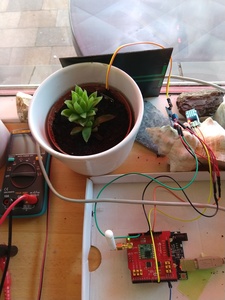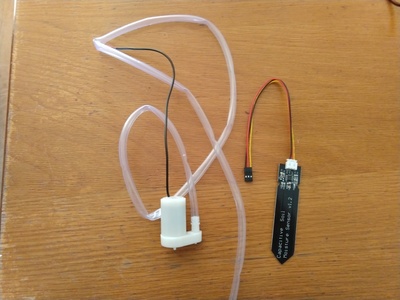Hello All,
Like to talk about by project a LoRa node based on a Arduino Pro Mini and an sx1276 LoRa module.
The LoRa node sends a payload to the TTN network, currently just calculated data, but will add one or more sensors soon. The node is powered by a set of 4 AAA rechargeable NiHM batteries and also connected a small (10cmx12cm, 12V) solar panel to charge the batteries.
The Arduino software is based on the 'ttn-abp' example from Thomas Telkamp and Matthijs Kooijman. It posts a Lora wan message to the TTN network every 2 minutes. I added an integration on the TTN network that posts the data to my on ASP .Net Core api and website running on a VM at the Google cloud, but that is another topic for the future.
I added the LowPower.h library from rocketscream (github) to reduce the power usage. I also removed the power led from the Arduino Pro Mini, to reduce the power even more. Currently it uses 60uA during the sleep.
The LoRa Node in action.
My wife just noticed the windowsill is filling up with Arduino's , Raspberry Pi and solar panels. ?
Peter
That's an awesome project Peter, thanks for sharing it with us
I think that you could make your wife happy by using a moisture sensor and a small water pump when you start adding I/O devices to this. You could create a solar-powered plant waterer to take care of those plants. She'd welcome the Arduino and Raspberry Pi then!
?
"Never trust a computer you can’t throw out a window." — Steve Wozniak
Great stuff! I really want to learn more about LoRa and will keep an eye on this thread. I'd like to learn how to create my own gateway at some point and use LoRa to communicate with clients around my property. I think there is a limit on how often you can send messages from a client to TTN correct? From my reading I thought that there are some standard protocols you need to follow if you wish to use other gateways, is this correct?
Hello Bill good idea,
Most plants need more attention. I already ordered some LDR sensors and I got a moisture sensor already, and also a DT11. So I can monitor light, temperature, humidity and moisture.
Only getting a small pump or valve and the project can start,
An than I also got some sensors to monitor instead of the computed values.
Hello garold,
Also planning to build my own (single channel) gateway with a Rasberry Pi 3B and a sx1276 module.
With the dragino LP01 gateway has a problem getting the downlink working (like many others), this is probably related to the hardware setup of the dragino. I got the version 1 of the Dragino LoRa development kit, they also have a version 2 of the development kit with a better (still single channel) gateway.
Maybe in the future I will build a full LoRa wan compatible gateway, but the price of the components will be between €100 and €200. Especially the concentrator, IC880A-SPI, RAK831 both need an extra converter board to fit on a Raspberry Pi. RAK also has a new concentrator RAK2245 that fits directly on a Raspberry Pi (3B+) I think this would be my first choice.
Yesteday also adjusted the backend and website to display the values.
Multiple values can now be added to one payload and send by LoRa.
Also added the values to be displayed on the graph at the website.
Something strange happend this morning with the moist value. It looks like the plant wake up and drunk all the water, or maybe the sun?
Time the check the sensor first, maybe a lose wire, bad connection?
It looks like a problem with the sensor. Some of the metal is completely gone on one side, time for a new sensor., or make one my self.
Will be continued...
Today created a moist sensor with 2 nails, a cap, 2 wires and some hot glue.
Tested its resistance with some soil. Completely dry 1M ohm, little wet 50K ohm, more water 10 K ohm and wet about 1 K ohm. Looks well, installed it and got a good signal again.
I expect this will last more than one day.
Very cool! How do you have that attached to the microprocessor? Just an analog input?
Yes, connected the
I created 2 sensors
At sensor 1 i used an 1k resistor and connected to analog input.
The other sensor is connected to the original moist sensor bord and the output is also connected to an analog input.
The analog value is now varies between 350 and 500, so good enough to sense is the plant needs water. It also looks like the value depends on temperature.
This is the graph, scaled the value to 0-100% of the analog value.
Hi Peter,
With your present set up the electrodes will corrode away over time and dissolve into the soil and that can be bad for the plant.
Can I suggest you invest in one of these:
Analog Capacitive Soil Moisture Sensor- Corrosion Resistant
This is just an example of one I found so I bet you can get something like it for $1 from China ?
They don't corrode so last longer.
I hope that helps.
The 600 series had rubber skin. We spotted them easy, but these are new. They look human... sweat, bad breath, everything. Very hard to spot.
Thanks for the advice.
Currently the sensor is only powered during the measurement, hopefully this will slowdown the corrosion and power consumption.
I already ordered 2 capacitive sensors for just over €2 at Aliexpress. Just have to wait. Probably will arrive during my holiday. After my holiday will test.
Will see how much power they consume during sleep, my goal is to power the LoRa node with a LiPo battery and a small solar panel. Must see how much power the capacitive sensor will use and if i can power down during sleep.
Hi Peter,
could you share your code for the lora node? I like the simplicity: using an Arduino Pro Mini.







